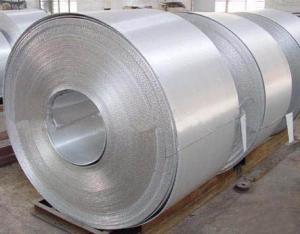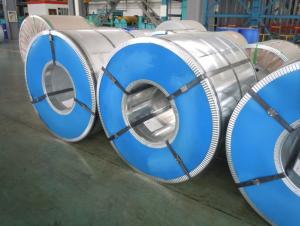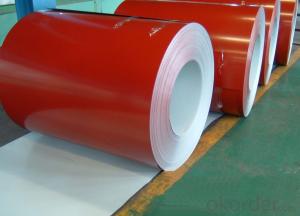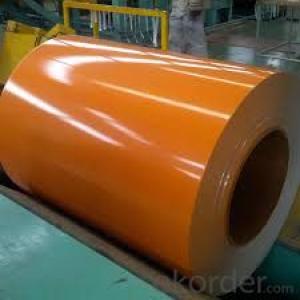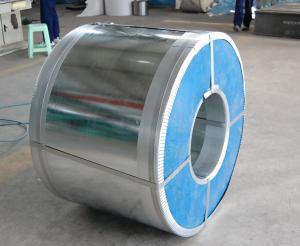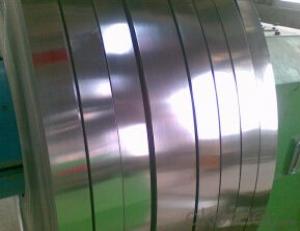galvalume steel coil with high quality e GL AZ60G-275G Anit-finger or oiled surface
- Loading Port:
- China Main Port
- Payment Terms:
- TT OR LC
- Min Order Qty:
- -
- Supply Capability:
- -
OKorder Service Pledge
Quality Product, Order Online Tracking, Timely Delivery
OKorder Financial Service
Credit Rating, Credit Services, Credit Purchasing
You Might Also Like
Packaging & Delivery
| Packaging Detail: | seaworthy packing |
| Delivery Detail: | 20~40 days after receiving desposit |
Specifications
galvalume coil with high quality
Thickness:0.3-2.5mm
Width:914-1250mm
AZ50~AZ150
galvalume coil with high quality
(1). Quality Standard: ASTM A792 CS-B SGLCC JIS G3321
(2). Thickness: 0.3-2.5mm
(3). Width: 914-1250mm
(4)Coil ID:508mm/610mm
(5). Coil Weight: 3~15MT
(6)Aluminium zinc layer:AZ50~AZ150G/M²
(7)Surface treatment:passivation treatment,oiling,anti-fingerprint treatment
(8)Packaging:seaworthy packing
- Q: what happened to all the steel beams from the WTC buildings? did anyone do any forensic analysisof any of the steel?
- some of the steel was recycled into a warship. I am not sure at what you are trying to get at with the forensic analysis of the steel. There is no conspiracy involving the towers outside of planes crashing into them despite what a lunatic fringe want you to think.
- Q: How do the sandpaper grits compare with different coarse levels of steel wool? For example, I'm finishing a homemade entertainment center, and using a tinted polyurethane, and it says to use 000 grade steel wool, but mine is #3, could I use some sanpaper instead, and what grit?
- Steel wool and wax is for the final buff after the finish coat. Sanding will scratch the finish and should only be done before the finish coat. Steel wool and wax have been used as the final finish to remove rough areas and buff the finish for a long time.
- Q: What are the different types of steel coil surface appearances?
- The different types of steel coil surface appearances include mill finish, pickled and oiled, galvanized, painted, and textured.
- Q: What are the different types of surface treatments for steel coils?
- There are several types of surface treatments for steel coils, including galvanizing, painting, and coating. Galvanizing involves applying a layer of zinc to protect the steel from corrosion. Painting involves applying a layer of paint to provide both corrosion resistance and aesthetic appeal. Coating involves applying a thin layer of protective material, such as polymer or epoxy, to enhance the steel's durability and resistance to corrosion. These surface treatments are chosen based on the specific requirements of the steel coils and the desired end-use applications.
- Q: I want to save water $$, so I want to use frozen steel to cool my coke. possible or no?
- Wouldn't it be easier to stick your coke in the freezer?
- Q: How would you calculate the maximum plastic deformation (expansion) a steel pipe can handle before it actually fails?
- You can calculate the maximum reversible strain, for elastic loading as follows: You need to look up the yield strength (for that particular type of steel). Divide this yield strength by the elastic modulus of steel (also called Young's modulus). That gives you the strain at the onset of yielding, the maximum you can strain the steel fibers before crossing the point of no return. If you are interested in the strain until failure, you need to take tensile test measurements. Seldom do people document an equation to model the non-elastic portion of the stress-strain curve of the specimen, because seldom do we design systems to operate with materials which yield. We want systems which only deform reversibly and elastically. This means you need to perform an experiment to find what you are actually desiring to know.
- Q: What are the common coil packaging methods?
- Common coil packaging methods include shrink wrapping, strapping, banding, and stretch wrapping. Shrink wrapping involves using a heat shrink film to tightly encase the coil, while strapping and banding utilize metal or plastic bands to secure the coil in place. Stretch wrapping involves wrapping the coil with a stretchable film to provide stability and protection. These methods are commonly used in industries such as steel, wire, and cable manufacturing.
- Q: What are the different types of steel coil surface protection methods?
- There are several types of steel coil surface protection methods, including oiling, painting, galvanizing, and plastic film coating.
- Q: What are the challenges in coil leveling for high-strength steel?
- Coil leveling for high-strength steel poses several challenges that need to be addressed in order to achieve optimal results. One of the main challenges is the inherent hardness and strength of the steel itself. High-strength steel is specifically designed to have enhanced mechanical properties, such as tensile strength and hardness, which make it more difficult to deform and shape. The high-strength nature of the steel requires specialized leveling equipment that can apply sufficient force to overcome its resistance to deformation. This may involve using stronger and more durable leveling rollers or increasing the pressure exerted during the leveling process. Failure to apply the appropriate force can result in incomplete leveling, leading to residual stress and potential dimensional inaccuracies in the final product. Another challenge in coil leveling for high-strength steel is the potential for springback. Springback refers to the tendency of the material to revert to its original shape after being deformed. High-strength steel is particularly prone to springback due to its higher elastic modulus. This can result in uneven leveling and dimensional variations in the coil. To mitigate springback, advanced leveling techniques may be employed, such as overbending or pre-bending the steel. Overbending involves bending the steel beyond the desired level, allowing it to spring back to the desired shape. Pre-bending, on the other hand, involves intentionally bending the steel in the opposite direction before leveling it, counteracting the effects of springback. These techniques require precise control and expertise to ensure accurate leveling. Additionally, high-strength steel often has a more pronounced yield point, which is the stress level at which permanent deformation occurs. This can make it more challenging to achieve consistent and uniform leveling throughout the coil. Proper adjustment of the leveling equipment and careful monitoring of the leveling process are necessary to address this challenge effectively. Furthermore, high-strength steel coils are often thinner and more sensitive to surface imperfections. The leveling process must be carefully regulated to avoid causing damage to the steel surface, such as scratches or indentations. This may involve utilizing softer leveling rollers or implementing protective measures, such as cushioning materials or coatings, to prevent surface defects. In summary, the challenges in coil leveling for high-strength steel revolve around its inherent hardness, springback tendencies, yield point behavior, and sensitivity to surface imperfections. Overcoming these challenges requires specialized equipment, advanced leveling techniques, precise control, and expertise to ensure accurate and high-quality leveling results.
- Q: Can steel coils be stacked on top of each other?
- Yes, steel coils can be stacked on top of each other.
Send your message to us
galvalume steel coil with high quality e GL AZ60G-275G Anit-finger or oiled surface
- Loading Port:
- China Main Port
- Payment Terms:
- TT OR LC
- Min Order Qty:
- -
- Supply Capability:
- -
OKorder Service Pledge
Quality Product, Order Online Tracking, Timely Delivery
OKorder Financial Service
Credit Rating, Credit Services, Credit Purchasing
Similar products
Hot products
Hot Searches
Related keywords
